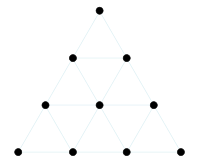LIMSwiki
Contents
| ||||
|---|---|---|---|---|
| Cardinal | ten | |||
| Ordinal | 10th (tenth) | |||
| Numeral system | decimal | |||
| Factorization | 2 × 5 | |||
| Divisors | 1, 2, 5, 10 | |||
| Greek numeral | Ι´ | |||
| Roman numeral | X | |||
| Roman numeral (unicode) | X, x | |||
| Greek prefix | deca-/deka- | |||
| Latin prefix | deci- | |||
| Binary | 10102 | |||
| Ternary | 1013 | |||
| Senary | 146 | |||
| Octal | 128 | |||
| Duodecimal | A12 | |||
| Hexadecimal | A16 | |||
| Chinese numeral | 十,拾 | |||
| Hebrew | י (Yod) | |||
| Khmer | ១០ | |||
| Armenian | Ժ | |||
| Tamil | ௰ | |||
| Thai | ๑๐ | |||
| Devanāgarī | १० | |||
| Bengali | ১০ | |||
| Arabic & Kurdish & Iranian | ١٠ | |||
| Malayalam | ൰ | |||
| Egyptian hieroglyph | 𓎆 | |||
| Babylonian numeral | 𒌋 | |||
10 (ten) is the even natural number following 9 and preceding 11. Ten is the base of the decimal numeral system, the most common system of denoting numbers in both spoken and written language.
Linguistics
- A collection of ten items (most often ten years) is called a decade.
- The ordinal adjective is decimal; the distributive adjective is denary.
- Increasing a quantity by one order of magnitude is most widely understood to mean multiplying the quantity by ten.
- To reduce something by one tenth is to decimate. (In ancient Rome, the killing of one in ten soldiers in a cohort was the punishment for cowardice or mutiny; or, one-tenth of the able-bodied men in a village as a form of retribution, thus causing a labor shortage and threat of starvation in agrarian societies.)
Mathematics
Ten is the smallest noncototient number.[1] There are exactly 10 small Pisot numbers that do not exceed the golden ratio.[2]
Decagon
A ten sided polygon is called a decagon.
Science
The SI prefix for 10 is "deca-".
The meaning "10" is part of the following terms:
10 is:
- The atomic number of neon.
- The number of hydrogen atoms in butane, a hydrocarbon.
- The number of spacetime dimensions in some superstring theories.
The metric system is based on the number 10, so converting units is done by adding or removing zeros (e.g. 1 centimetre = 10 millimetres, 1 decimetre = 10 centimetres, 1 meter = 100 centimetres, 1 dekametre = 10 meters, 1 kilometre = 1,000 meters).
Music
- The interval of a major tenth is an octave plus a major third.
- The interval of a minor tenth is an octave plus a minor third.
Religion

Abrahamic religions
The Ten Commandments in the Hebrew Bible are ethical commandments decreed by God (to Moses) for the people of Israel to follow.
Mysticism
- In Pythagoreanism, the number 10 played an important role and was symbolized by the tetractys.
- There are Ten Sephirot in the Kabbalistic Tree of Life.
- In Chinese astrology, the 10 Heavenly Stems, refer to a cyclic number system that is used also for time reckoning.
See also
Notes
References
- ^ "Sloane's A005278 : Noncototients". The On-Line Encyclopedia of Integer Sequences. OEIS Foundation. Retrieved 2016-06-01.
- ^ M.J. Bertin; A. Decomps-Guilloux; M. Grandet-Hugot; M. Pathiaux-Delefosse; J.P. Schreiber (1992). Pisot and Salem Numbers. Birkhäuser. ISBN 3-7643-2648-4.

















